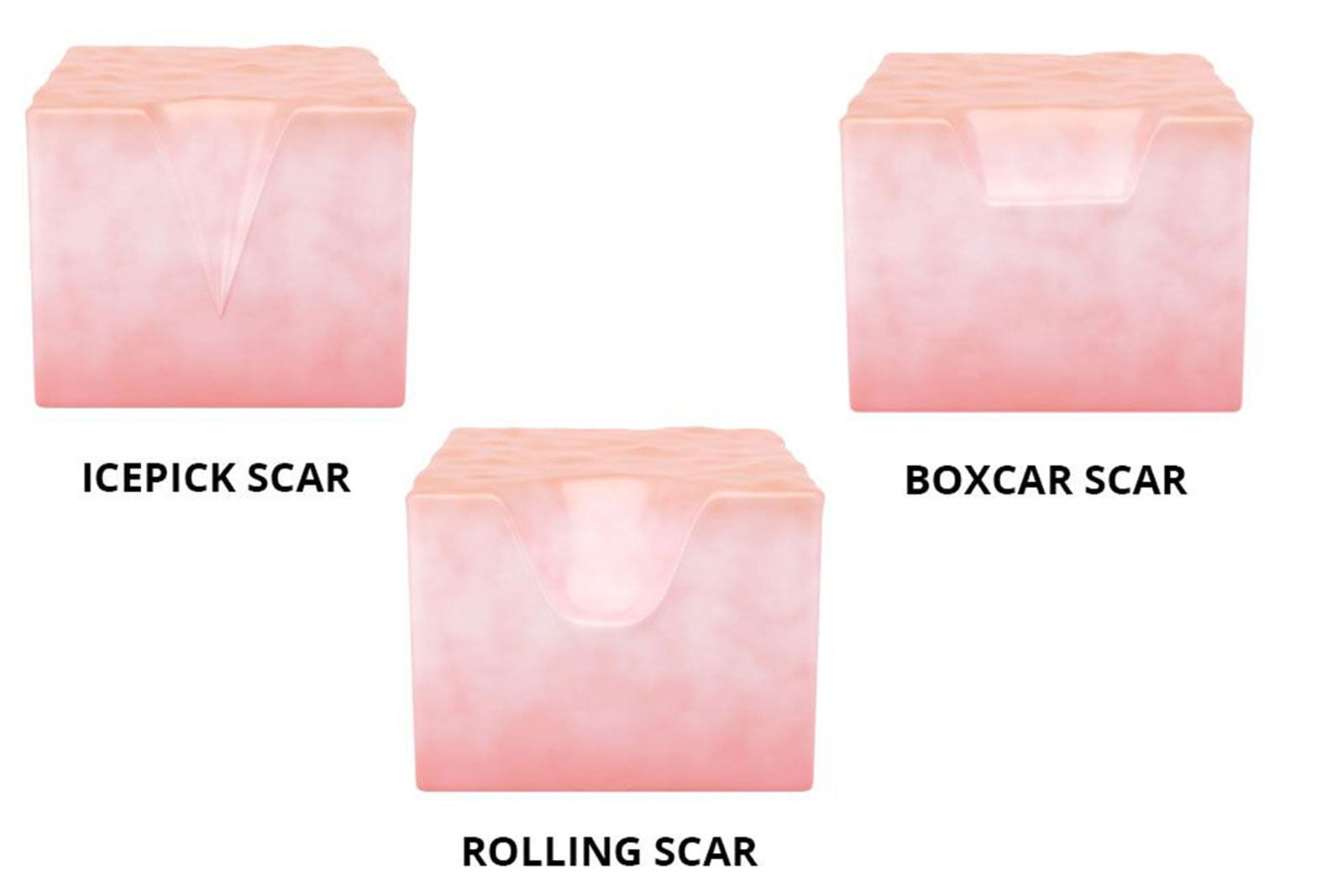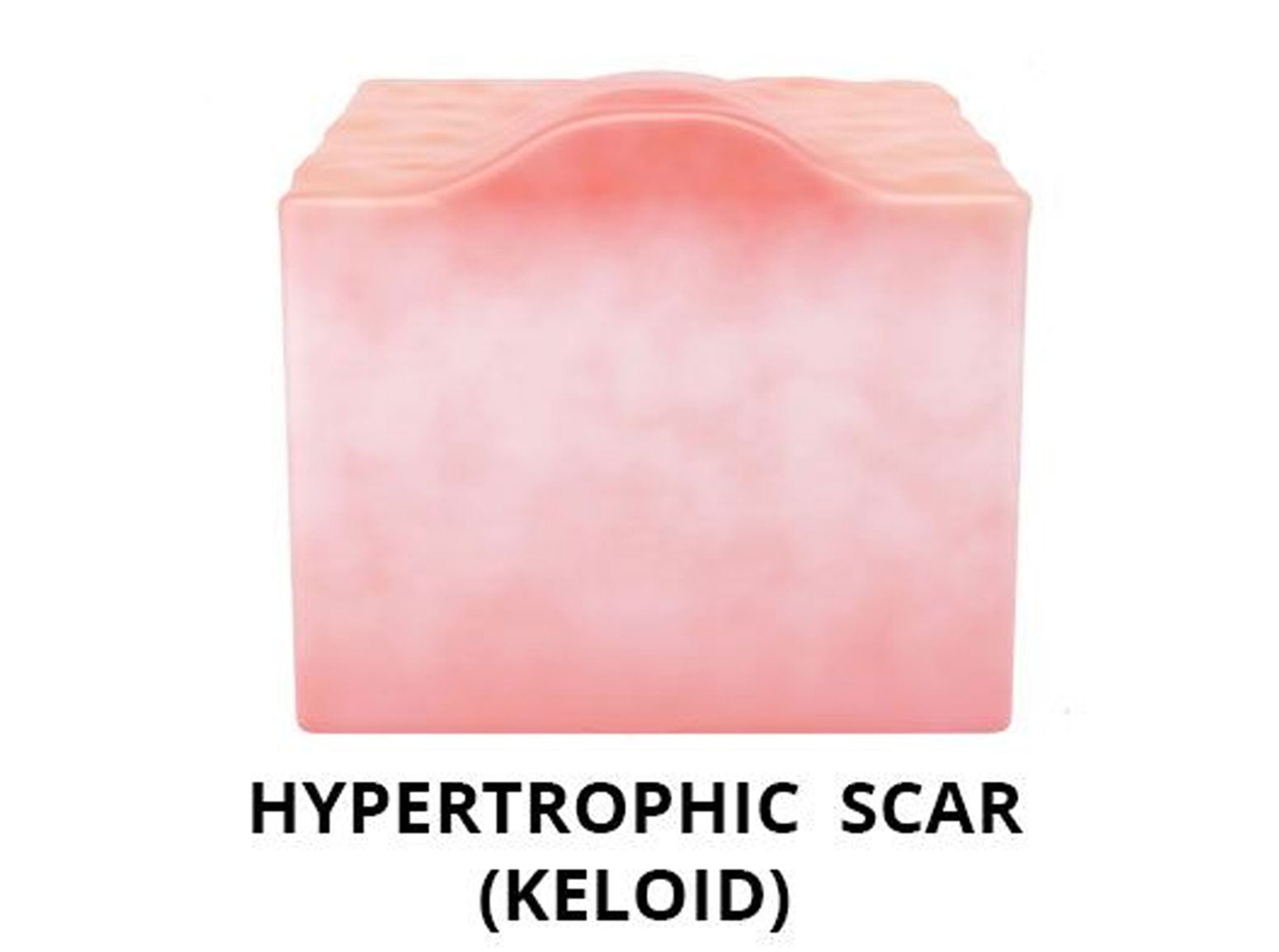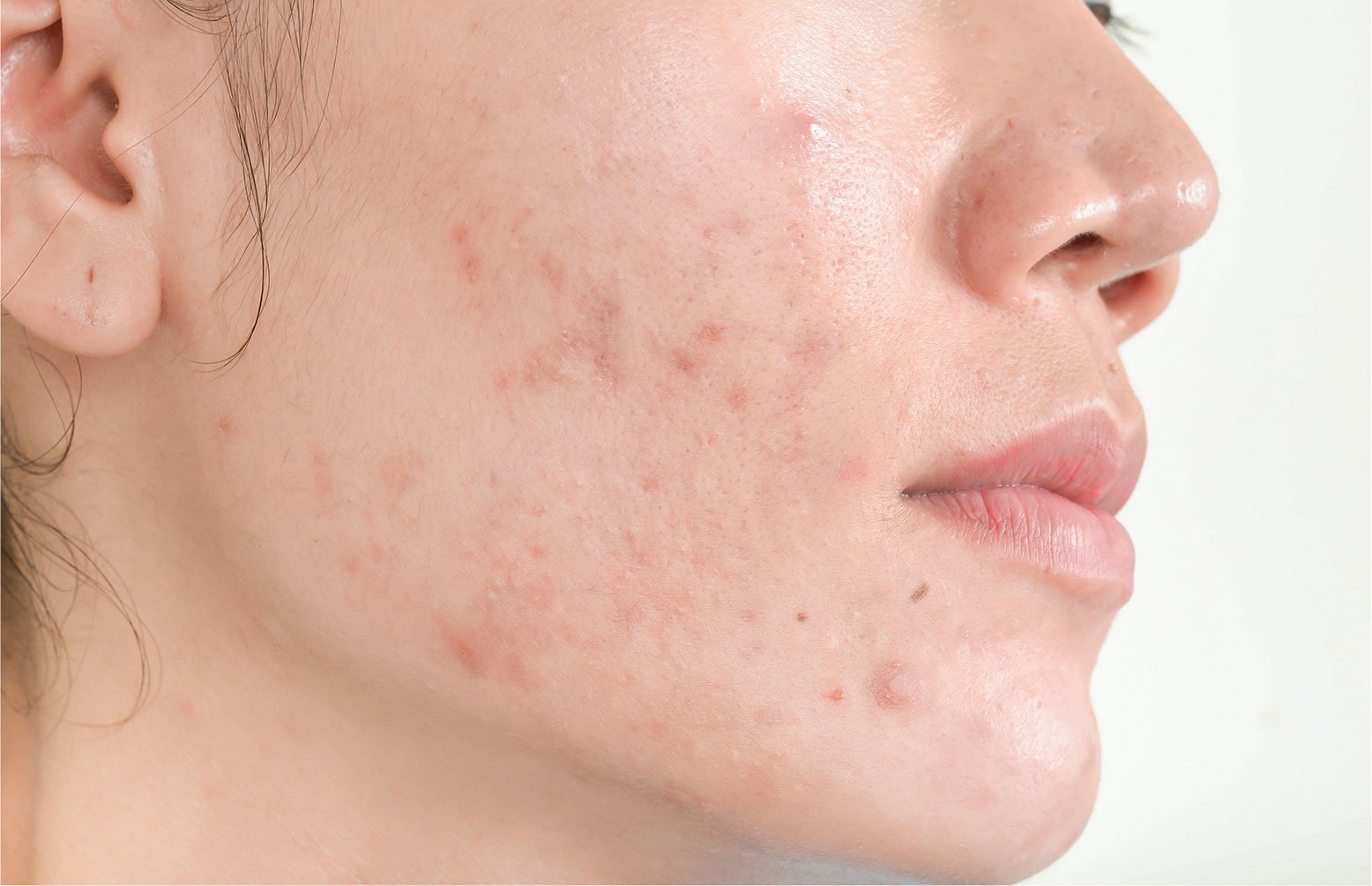Can You Get Rid of
Deep-Pitted Acne Scars?
What Are Deep Pitted Acne Scars?
Deep pitted acne scars are the result of severe or cystic acne. As your skin cells regenerate, some of your tissue is lost, which over time will leave scarring, dimples, and depressions in your skin.

Atrophic
Atrophic scars are shallow and have healed underneath the top layer of the skin, leaving a depression caused by collapsed and condensed collagen. The subclassifications of atrophic scars are:
- Ice pick – deep, narrow, pitted scars that resemble holes in the skin
- Rolling – sloping edges which make the skin look wavy and uneven
- Boxcar – larger than ice pick scars with sharply defined edges that look like craters
- Atrophic superficial – typically ivory in color with a flat, wrinkled appearance resembling a small stretch mark
VIEW TREATMENTS
Hypertrophic and Keloid
Hypertrophic and keloid scars are raised versions of healed skin with a white, pink, or dusky coloration. They’re often tender, itchy, and have a waxy feel to them. Hypertrophic scars stabilize at the site of the original pimple and remain slightly raised. Keloid scars begin to spread through newly made bundles of tightly wound collagen beyond the origin of the original pimple. High-risk areas for these scars include the jawline, back of the neck, center chest, and shoulders.
For both types of scars, it’s common to have an overproduction of collagen. The gold standard of treatment for these remains Kenalog (steroid) injections that break down excess collagen, producing softer, flatter, and less symptomatic scars. These injections are generally performed in a series over time.
VIEW TREATMENTS


Post-inflammatory Hyperpigmentation
Also known in abbreviated form as PIH, this is not exactly a scar, but a discolored spot or area that is the result of squeezing and picking of the acne itself. The healing process blurs the top layer from the underlying layer of the skin, and pigmentation cells become trapped among collagen fibers. Older blood vessels remain at the site of healing, giving it a darker appearance.
VIEW TREATMENTS
Treatments for Deep Pitted Acne Scars
A combination of treatments is often required, because patients have more than one type of deeply pitted scarring. Many treatments can help in treating several types of scarring too! PIH can be improved with laser genesis, chemical peels, and micro needling. Ice-pick and boxcar scars can be treated with fractionated ablative laser, microneedling, subcision, and filler injections.
Stage 1 Treatment
As multiple treatments may be required, it is best to treat deeply pitted scars in stages. An initial stage of treatment may include:
TCA Cross
TCA Cross is droplets of trichloroacetic acid applied in a high concentration directly into the appropriate scars to cause an inflammatory reaction, leading to new collagen formation to fill the deep pit.
The purpose is to improve the look of the scarred skin by filling in the scar, therefore reducing reflection and shadows, minimizing the look of the scar, and providing the appearance of smooth skin.
Once the area of scar treatment has been degreased, a small toothpick is saturated in the acid, then applied into the scar. The scar will immediately frost over in white, and you will have to leave the clinic like this. It’s best to keep the treated areas slightly moist using an occlusive barrier such as Vaseline or Aquaphor. In the days ahead, they will scab and repair as a typical wound would.
It’s common for scars to be treated two to five times with TCA Cross over a period of six to eight weeks apart for the desired result. This is not a rapid results treatment, so patients must manage their expectations with a range of six months to a year.
Punch Excision
This technique for the revision of acne scars is reserved for isolated ice pick and very small boxcar scars. It’s performed with a tool used for punch biopsies, and is able to excise firm, trapped, scar tissue. The level edges are then sutured to close it up and heal. leaving a small, even hairline scar.
Both TCA Cross and Punch excisions need to be followed up with another treatment modality. They’re considered Stage 1 treatments and must be followed with a Stage 2 treatment such as laser resurfacing and microneedling.
Stage 2 Treatment
Stage 2 treatment options are viable once you have completed the first stage and can take your skin to the next level in terms of evenness, tone, smoothness, and texture.
Subcision
Subcutaneous incisional surgery is a perfect treatment for rolling scars. It works by the use of a hypodermic instrument, such as a cannula or needle, that is inserted by way of a small puncture and used to break fibrotic bands that are tethered to the tissue underneath. By untethering these fibrotic bands, you are creating space, which allows for new collagen structures and formation by the process of wound healing.
This treatment works exceptionally well with the placement of hyaluronic acid fillers underneath where the scar was tethered, to act as a support bridge while new collagen forms.
Fractional Laser Resurfacing
This laser resurfacing treatment works by creating microscopic, pixelated punctures which represent an injury zone (1/100mm and smaller). These are created with an energy source, leaving the surrounding skin intact as so-called skip zones. The laser can be set to deliver 10 to 50% fractionated wound columns. One can expect up to 20% improvement per treatment with a minimum of four to six treatments or more for atrophic (indented or pitted) scars.
Creating this dermal injury allows the benefits of the body’s wound healing process to occur in the various layers of the skin. An immediate improvement can be seen once the epidermal layer from the microscopic scabs shed. The injury in the deeper dermal areas work to rebuild new collagen over time for long term benefits. The greater the density or percentage coverage of thermal injury zones per treatment, the greater the immediate swelling, redness and healing. As a result, healing downtime can be individualized. This treatment is great for removing PIH and smooth surface scars – with precautions, it can be used on all skin types!
Full Field Laser Resurfacing
Full field laser resurfacing treats the entire face by removing the top layer of skin. A laser beam scans the treatment zone with precision and removes the layer. This treatment can only be performed on light skin types. There is downtime associated with full field laser resurfacing, lasting from two to three weeks and erythema that can last for a number of months. However, for the right candidate with severe, deep textural scarring, it is worth it to create new, smooth skin.
IPL/ BBL/ Laser Genesis
Photorejuvenation: We have various light and laser therapies that can be used on a range of skin types to assist with lifting stubborn PIH and residual redness. These are the least invasive of the laser and light therapies with little down time, but they are only attracted to the pigmentation and will not assist with other types of acne scars.
Depigmentation skin care which will assist with removing PIH or act as a pre or post treatment for laser resurfacing treatments is also available. Z.O. medical skin care and Universkin boutique ingredients provide unique lightening opportunities that are well tolerated, non-invasive, and affordable.

Authors Dr. Marnie Fisher & Dr. Elena Poulous
Dr. Fisher, Dr. Poulos, and the dermatologists at Kingsway Dermatology & Cosmetic Centre have a combined 20 to 25 years of experience each of providing both medical, surgical and cosmetic care for acne and acne scarring.
Dr. Fisher and Dr. Poulos are your expert dermatologists here at Kingsway Dermatology & Cosmetic Centre, who have spent decades of their lives working with all kinds of skin types to bring patients satisfaction with the skin they’re in.

